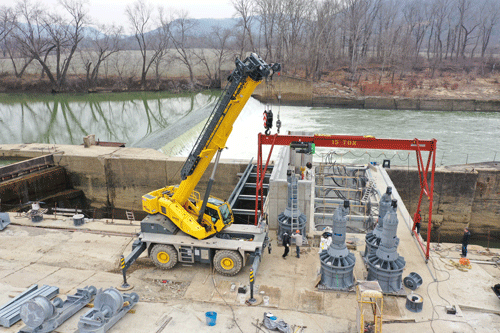
Even in coal-dominated Kentucky, renewable energy is getting more attention as federal and state tax incentives add up and the federal government moves closer to capping carbon dioxide emissions and making coal power more expensive. While other states have abundant wind or sunshine making them good candidates for wind and solar power, Kentucky has substantial and consistent rainfall and a lot of rivers. Many of the rivers are already dammed for navigation, flood control or recreation, giving the state a potentially rich hydroelectric power resource.
A Financially Feasible, Reliable Power Source
The United States Department of Energy (DOE) has identified small, low-head dams as the largest source of potential future development at existing nonpower dams. The development of many of these small dams has not proven financially viable with conventional equipment and technology.
Seeking to change that, Appalachian Hydro Associates (AHA) in Ravenna, Kentucky, set out to develop a more cost-effective model for small hydro projects. AHA president David Brown Kinloch, who has experience with previous hydroelectric power projects in the area, focused his attention on abandoned lock chambers along the Kentucky River.
According to Brown Kinloch, the town of Ravenna was once a major hub where all the coal mined in Eastern Kentucky passed through.
“Boats used to bring coal down river to market from up in the mountains,” Brown Kinloch said. Most of the locks were abandoned by the 1990s when rail and highways offered faster and cheaper transportation alternatives.
In 2015, the Federal Energy Regulatory Commission issued a license for a hydroelectric project on Lock 12, not far from the town of Ravenna. The ability to place hydro turbines in the lock chamber helped dramatically reduce project costs, but AHA still needed a partner to help offset the upfront investment costs.
Berea College, located in Berea, Kentucky, has a commitment not only to the environment and sustainability, but also to the community of eastern Kentucky.
“This project is good in so many ways,” said Lyle Roelofs, president of Berea College. “We serve students from all the counties of Kentucky, including Estill County where the project is and Jackson County where the electricity is going.
Just the fact that we are creating half of the energy we use on campus without burning a lick of coal is the biggest plus in all of this.”
Former Lock Chamber Repurposed
With Berea College on board, AHA turned to a global water solutions and technology company to help design the hydroelectric power solution driven by submersible hydro turbines. Installed in new hydro plants or existing structures, such as old mill sites and lock chambers, submersible turbines are adaptable and can be made to work at almost any site. With low initial investment cost and pump longevity, the return on investment in small scale hydro is short, which leads to good profitability.
“There is a simple reason why submersible turbines are chosen,” Brown Kinloch said. “Operating submerged, and out of the way, no expensive superstructure is required.”
Due to the narrow size of the lock chamber, engineers suggested a modified hydro turbine pump. According to Jillian Davis, the project’s design engineer, the lock chamber is just 52 feet wide.
“That does not give you a lot of room, but because of the diameter of the units, we were able to fit multiple [hydro
turbine] pumps in that 52-foot width,” she said. Ultimately, the lock fit five large hydro turbines.
The modified hydro turbine has a custom modular design specifically for water locks, with a draft tube that is narrower and taller to regain some losses and increase the efficiency of the turbine.
Before construction of the Lock 12 project got underway, Roelofs and members of Berea College’s executive team toured the plant to see the hydro turbines being manufactured. Throughout the construction of the Lock 12 hydroelectric power plant, heavy rains plagued the project, causing frequent delays. Despite construction delays, the project team knew they had a hydroelectric solution that, once operational, could withstand such floods in the form of the submersible hydro turbines.
To manage the ongoing floodwaters, dewatering pumps were used to keep water out of the project site while the crews poured the concrete to the support structure for the hydro turbines.
After two years of construction, the 2.64 megawatts (MW) Ravenna Hydroelectric Project went online in June 2021. Most of the flow of the Kentucky River will pass through the hydro turbines, each producing up to 500 kilowatts (kW) of energy, which flows into and is sold to the Jackson Rural Electric Cooperative. In turn, it will be a revenue resource for Berea College. The amount of power is approximately half of the amount used on the college campus.
“To put it in perspective, we’ll probably be making enough electricity for about 1,200 average Kentucky homes,” Roelofs said.
With at least 14 lock structures on the Kentucky River, AHA now has a hydroelectric power solution that can be easily replicated in other lock structures located upstream or downstream with minimal reengineering necessary.
With plans to install hydroelectric power plants in at least four more lock structures on the upper Kentucky River, Roelofs said hydroelectric power projects like Lock 12 are bringing hope to an area that has been economically depressed since the coal industry downturn.
Despite the long journey, the Ravenna Hydroelectric Project is now making good, clean, inexpensive power that can be sold to the local electric cooperative at a discount, saving members money.

